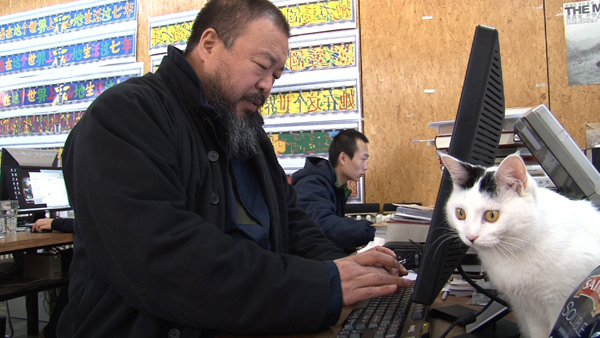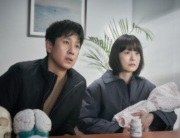
Ai Weiwei in his studio (Sundance Selects)
Last year, journalist Alison Klayman’s camera was at the eye of the international human rights storm over Chinese artist Ai Weiwei. Her resulting debut documentary goes behind the headlines to intimately show why he became famous, first for his multi-media art and architecture, then for how he puts his talents towards pointed political activism.
So much of Ai Weiwei’s performance art plays out in front of cameras that Klayman’s introductory interviews verge on collusion. Hers is among the many, many he does for the international media. He seems to cannily and aggressively combine self-promotion with his aggressive calculation that the world media attention would continue to provide protection for his political protests. His art is expansively (if sometimes confusingly and repetitively) revealed in unique relation to his biography and imposing personality. In a response to how the Chinese government has responded to his activities and popularity, he says, “My opponent moves, I move.”
Klayman helpfully weaves together Ai Weiwei’s look back at his life while closely following him over two calamitous years. His father, Ai Qing, was a Communist poet deemed too intellectual for the Cultural Revolution, and his family accompanied him to rural banishment. The father’s official rehabilitation came in time for his son to attend art academy in Beijing. Dissatisfied with academic restrictions, Ai Weiwei joined the first generation to study abroad, and from 1981 he spent more than a decade in the United States, including living in New York’s Lower East Side, where he describes the influence of Allen Ginsberg, punk rockers, street protests, as well as TV coverage of the 1987 Iran-Contra Congressional hearings and the 1989 Tiananmen Square crackdown, against which he joined a hunger strike in front of the United Nations. Back home, Ai Weiwei flouted authority by impudently incorporating revered images of Chinese culture—smashing Han vases, raising the finger at Tiananmen Square—in artworks that were given prominence overseas, while in China his commercial architecture and design practice boomed.
The film is most absorbing in marking how his art, life, and politics intertwined since 2008, starting when he used the international visibility of his showcase Bird’s Nest design at the Beijing Olympics to challenge government propaganda, especially in the aftermath of the massive earthquake in the southwest. (Jon Alpert and Matthew O’Neill’s Oscar-nominated 2009 short documentary, China’s Unnatural Disaster: The Tears of Sichuan Province, vividly revealed upright private buildings next to crumbled public schools.) In Munich, he set up an epic commemorative collage of over 5,000 children’s colorful backpacks to spell out the Chinese characters of a grieving mother’s eulogy: “She lived happily on this earth for seven years.” But as he goes beyond memorials to force officials to acknowledge the individual children’s deaths, he and his online collaborators collect and read out the children’s names, in tweets, video blogs, and detailed charts, though it’s not clear how he gets around the Great Firewall.
When his testimony in support of an independent investigator is violently thwarted by government thugs, his crew films the attack, and then defies the constant surveillance on him by setting up cameras next to the government’s, including recording the forced demolition of his new studio. Though purists may call this action political protest and not art, it looks like a sophisticated version of 1960’s “the whole world is watching” agit-prop updated to the Internet age.
The latest government charge of “bigamy” against him is clarified near the end when Ai Weiwei opens up more about his complicated domestic arrangement. He’s seen stiffly playing with a toddler he fathered with an assistant, which makes it a bit awkward that his artist wife of over 16 years, Lu Qing, is arrested for participating in his work and her movements are restricted. The government’s ratcheted up threats against his family are a sobering look at the power of oppression.
As of last month, he and his supporters continue to provoke the authorities by mocking online the legal proceedings against him, testament to the creative, yet stubborn and inspiring, human spirit.






Leave A Comment